Political scientists have a fondness for rankings. We rank our journals (Garand and Giles Reference Garand and Giles2003; Giles and Garand Reference Giles and Garand2007), our book presses (Goodson, Dillman, and Hira Reference Goodson, Dillman and Hira1999), our departments (Ballard and Mitchell Reference Ballard and Mitchell1998; Garand and Graddy Reference Garand and Graddy1999; Hix Reference Hix2004; Masuoka, Grofman, and Feld Reference Masuoka, Grofman and Feld2007b; Miller, Tien, and Peebler Reference Miller, Tien and Peebler1996), our graduate programs (McCormick and Rice Reference McCormick and Rice2001), and each other (Klingemann, Grofman, and Campagna Reference Klingemann, Grofman and Campagna1989; Masuoka, Grofman, and Feld Reference Masuoka, Grofman and Feld2007a). These rankings have elicited considerable discussion—particularly from those people who believe that their department, favorite journal, or university classification has received unfair treatment (e.g., Thatcher and Thatcher Reference Thatcher and Thatcher2007; Crowe and McWilliams Reference Crowe and McWilliams2008; Frederking Reference Frederking2008). Of course, these debates are not unique to political science. Economists (Kalaitzidakis, Mamuneas, and Stengos Reference Kalaitzidakis, Mamuneas and Stengos2001), psychologists (Anseel et al. Reference Anseel, Duyck, Debane and Brysbaert2004; Boor Reference Boor1982), and sociologists (Allen Reference Allen1990) also engage in byzantine debates over rankings.
Although some people might dismiss these debates as pointless navel-gazing, tenure decisions, hiring decisions, and career choices are often made based on disciplinary rankings. It is not uncommon for academics to define career success by departmental and journal rankings. Publication in one of the “big three” journals (American Political Science Review, American Journal of Political Science, and Journal of Politics) can serve as a defining moment in the career of a political scientist, and even the least vain among us would prefer to have our work published in more highly ranked journals than those outlets with less prestige.
Absent from many of these discussions, however, are the scholarly contributions of people from departments that do not offer a Ph.D. For example, many studies of political science departmental rankings build upon the National Research Council's study of departments with Ph.D. programs (e.g., Garand and Graddy Reference Garand and Graddy1999; Ballard and Mitchell Reference Ballard and Mitchell1998), thus excluding scholars from departments that only grant bachelors' or masters' degrees. Recent studies such as the “Political Science 400” (Masuoka, Grofman, and Feld Reference Masuoka, Grofman and Feld2007a) do not consider the productivity of scholars from non-Ph.D. departments. In addition, when journals are ranked and scored by reputation, academics from non-Ph.D. departments are often not invited to respond to the survey (Giles and Wright Reference Giles and Wright1975; Giles, Mizell, and Paterson Reference Giles, Mizell and Paterson1989; for an alternative approach, see Garand and Giles Reference Garand and Giles2003).
Ignoring the work of scholars from non-Ph.D. departments leaves out nearly half of the political scientists in the country. Approximately 44% of the American Political Science Association's (APSA 2008) nonstudent membership works at a non-Ph.D. institution. Moreover, non-Ph.D.-granting institutions compose well over half of the members of the Interuniversity Consortium for Political and Social Research (ICPSR 2008). Scholars have noted the research potential of these non-Ph.D.-granting departments, including one recent article published in the Chronicle of Higher Education that argued that, “for junior faculty members, the best place to focus on research may not be at a research university” (Ghodsee Reference Ghodsee2008, C1). Many scholars have even called for more consideration of non-Ph.D. departments as first-choice career opportunities for academics (Crowe and McWilliams Reference Crowe and McWilliams2008; Frederking Reference Frederking2008; Ghodsee Reference Ghodsee2008; Henderson Reference Henderson2007).
To gain a better understanding of the scholarly productivity of non-Ph.D. departments, we focus on three primary research questions. First, what are the publishing rates of scholars from non-Ph.D. departments? Second, do faculty from non-Ph.D. departments publish in different types of journals than do faculty from Ph.D.-granting departments? Third, do the affiliations of a journal's editorial board members correspond to the institutional affiliations of published authors in that journal?
DATA AND METHODS
Many studies analyzing journal authorship focus on the top three journals in the discipline. Because one of the primary research questions of our study is whether an author's institutional affiliation varies by journal, however, we expanded the universe of journals evaluated and coded every article longer than two pages in 26 top political science journals from 2000 to 2007.
To create our sample of journals, we began with the journals with the 20 highest impact ratings, as reported by Garand and Giles (Reference Garand and Giles2003). We then excluded three journals that were outside of the political science field (American Sociological Review, American Economic Review, American Journal of Sociology). Although many political scientists publish in journals outside of their discipline, we wanted this initial study to focus on publication rates within the discipline's journals.
Following work about publishing patterns in sociology (Eckberg and Marx Reference Eckberg and Marx2004; Marx and Eckberg Reference Marx and Eckberg2005), we also added nine of the official journals of the APSA's organized sections. We excluded New Political Science and Party Politics, official subfield journals, from this list because of access problems from our university library. In addition, since we began data collection, Politics and Religion and the Journal of Information Technology and Politics were added as new section journals. These journals were not included in our dataset. Despite some notable holes, this list should provide an understanding of publishing across subfields.
We should also note that the author, rather than the article, is the unit of analysis. We made this coding decision because we did not want to unnecessarily discount coauthored contributions. Coauthorship is increasingly common and accepted within political science (Chandra et al. Reference Chandra, Gandhi, King, Lupia and Mansfield2006; Fisher et al. Reference Fisher, Cobane, Vander Ven and Cullen1998; Sigelman Reference Sigelman2006). As King notes, “In most of the social sciences, credit is not divided among the coauthors: each coauthor gets almost full credit for the entire paper” (Reference King2006, 121). Coauthored articles are even cited more than their single-authored counterparts (Montpetit, Blais, and Foucault Reference Montpetit, Blais and Foucault2008).
We classified each author into one of four affiliations: authors affiliated with departments in the United States that do not offer a Ph.D. (hereafter referred to as non-Ph.D. departments), authors affiliated with departments in the United States that do offer a Ph.D. (Ph.D. departments), authors affiliated with departments located outside of the United States (non-U.S. departments), and authors affiliated with an organization located outside of the higher education system (nonacademic institutions). The process of classifying authors was fairly straightforward for non-U.S. departments and nonacademic institutions. Likewise, in cases in which a department offers a Ph.D. in political science, we simply coded the author as being located in a Ph.D. department. However, some departments have Ph.D. programs in areas related to political science, such as public administration and policy. Although such a program is not a Ph.D. in political science, it is offered by the department, and presumably, department members receive many of the benefits of a Ph.D. program. As a result, we coded authors from these types of departments and similarly situated programs as Ph.D. departments. Another issue arose concerning departments without a Ph.D. program located in a state flagship offering Ph.D.s in other fields. Although the department is embedded in a larger, research-oriented university, no Ph.D.s are granted within the department, and we therefore coded authors from these departments as non-Ph.D. departments.
Another challenge related to coding academics who are not political scientists. Although sociologists, economists, and public administration scholars publish in political science journals, we coded all authors as if they were political scientists. This issue is not a large problem, because when non–political scientists are represented, they are much more likely to work at universities in which virtually every department offers a Ph.D. or else no departments offer a Ph.D. The decision to collapse all categories into one was also necessary because many journals do not include department affiliation, making it very difficult to track down the specific affiliation of each author.
Following the procedures outlined here, we compiled a dataset with 10,804 cases from 26 journals over a seven-year period. Table 1 shows all of the journals in our sample, the abbreviation for each journal, the rationale for inclusion, the number of cases coded, and the number of articles included. It is important to note that three of our journals (the Journal of Political Science Education, Politics and Gender, and State Politics and Policy Quarterly) were founded after 2000, and we therefore coded them beginning with their first issue.
Table 1 Journals in the Study
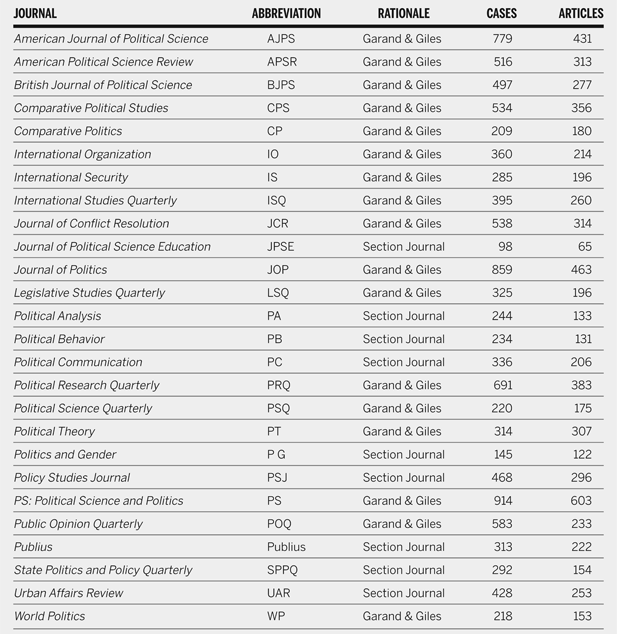
As a further clue to the visibility of scholars from non-Ph.D. departments, we coded editorial boards from the 26 journals in our study. Rather than coding all years, we coded editorial boards from 2008, because we expect that editorial boards lag behind publication patterns. If editorial boards at least partially make up the pool of frequent writers for journals, we would expect to see publication patterns from 2000 to 2007 reflected in the editorial board memberships from 2008.
PUBLICATION PATTERNS IN POLITICAL SCIENCE JOURNALS
How much of the work in political science journals comes from scholars in departments without a Ph.D. program? Approximately 16% of all the authors published in these 26 journals were affiliated with non-Ph.D.-granting departments, while faculty at Ph.D.-granting departments represented 66% of all the authors in the dataset. Moreover, approximately 13% of authors represented non-U.S. departments, and slightly fewer than 5% of the authors were affiliated with nonacademic institutions.
A primary goal of this study was to determine how authorship varies by journal type. The results, presented in figure 1, suggest that authorship patterns vary widely across journals. While political scientists from non-Ph.D. departments contributed to each journal in this study, these scholars appear to make their strongest impact in the discipline's teaching journal. Over 66% of the authors in the Journal of Political Science Education are affiliated with non-Ph.D. departments—a sign that academics from these departments may be particularly attuned to Boyer's (Reference Boyer1990) call for more work on the scholarship of teaching and learning (see also Henderson and Buchanan Reference Henderson and Buchanan2007).
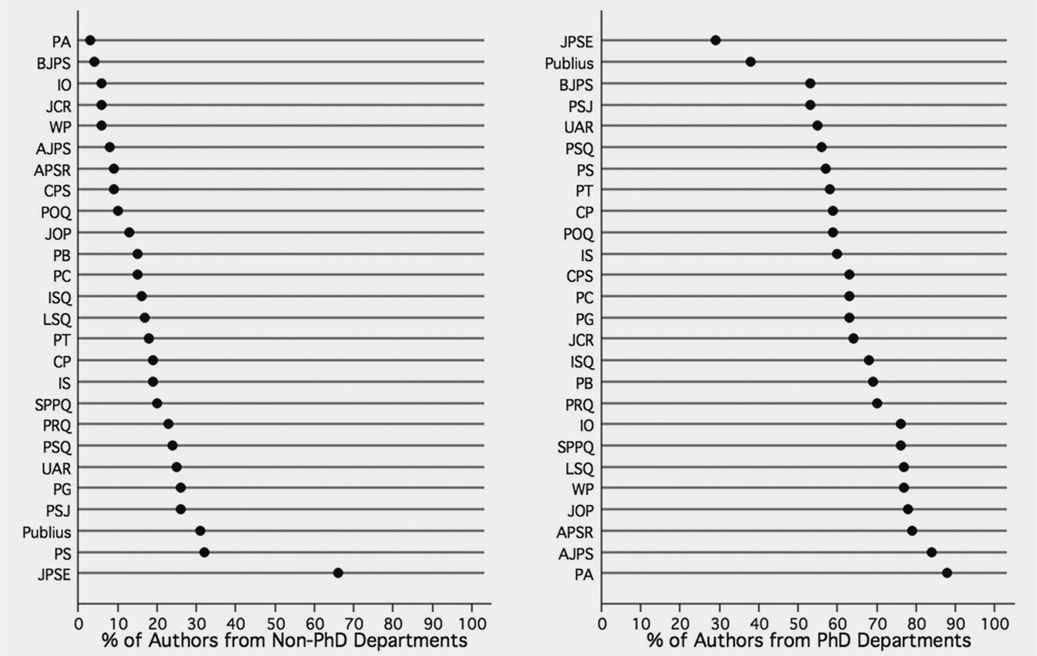
Figure 1 Publication Patterns of Authors from Ph.D. and Non-Ph.D. Departments
U.S. scholars not affiliated with Ph.D. departments also made substantial contributions to several other journals, representing at least one-quarter of authors in PS: Political Science and Politics (32%), Publius (31%), Politics and Gender (26%), Policy Studies Journal (26%), and Urban Affairs Review (25%). Scholars from non-Ph.D. departments also represented at least one-fifth of authors in State Politics and Policy Quarterly (25%), Political Science Quarterly (24%), and Political Research Quarterly (23%). Political scientists from non-Ph.D. departments appeared less frequently in journals published outside the United States or journals with a more international focus, including Political Analysis (3%), British Journal of Political Science (4%), World Politics (6%), Journal of Conflict Resolution (6%), and International Organization (6%).
While the focus of our project was to assess publication rates by U.S. political scientists, our data also include contributions from nonacademics and faculty from educational institutions outside of the United States, as displayed in figure 2. Authors from nonacademic institutions represent less than 10% of authors in each of the journals included in our study, except Public Opinion Quarterly. The importance of public opinion research outside of academia likely explains the large number of contributions from nonacademics in this journal. In fact, 5 of the 32 members of the journal's editorial board work outside of academia. The journal Political Theory has the lowest percentage of contributors affiliated with nonacademic institutions.
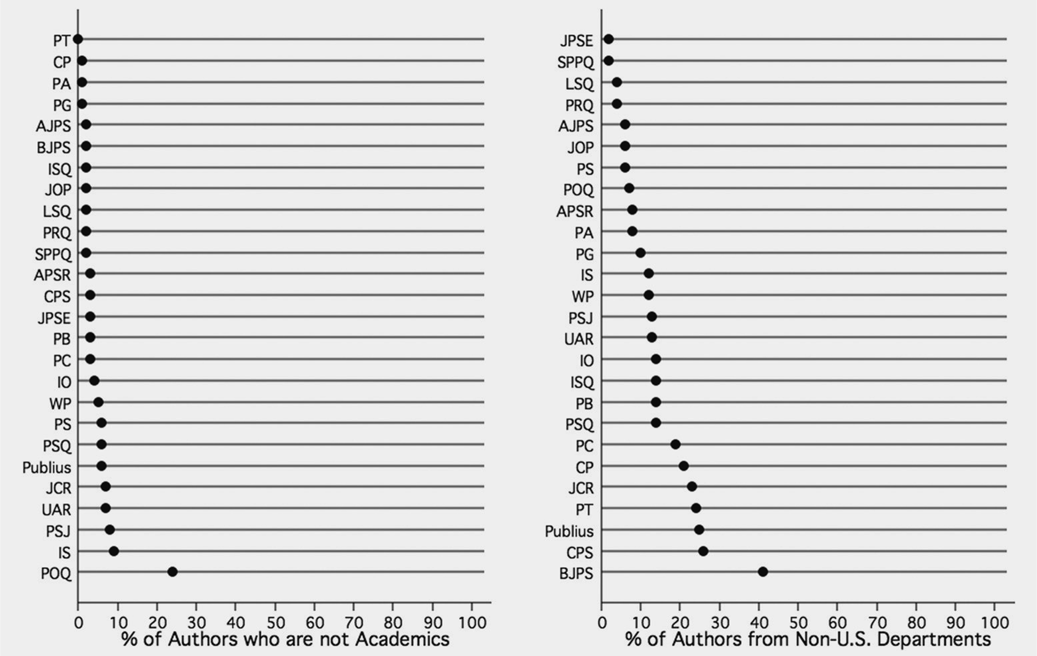
Figure 2 Publication Patterns of Nonacademics and Authors from Non-U.S. Departments
Not surprisingly, the contribution of academics from non-U.S. departments is much greater in comparative and international politics journals (see figure 2). The high percentage of authors from non-U.S. universities in Publius was somewhat surprising, although the journal does focus on federalism around the world. The Journal of Political Science Education and State Politics and Policy Quarterly have the lowest percentages of authors from non-U.S departments.
To better understand authorship affiliation and journal impact, figure 3 displays the relationship between the percentage of authors affiliated with non-Ph.D. departments and the Garand and Giles (Reference Garand and Giles2003) impact rankings. Some of the journals (e.g., State Politics and Policy Quarterly, the Journal of Political Science Education, and Politics and Gender) were not rated by Garand and Giles (Reference Garand and Giles2003) and thus are not included in figure 3. The general trend, as displayed by the fitted values line, is that authorship by faculty from non-Ph.D. departments declines as the journal's impact ranking increases.
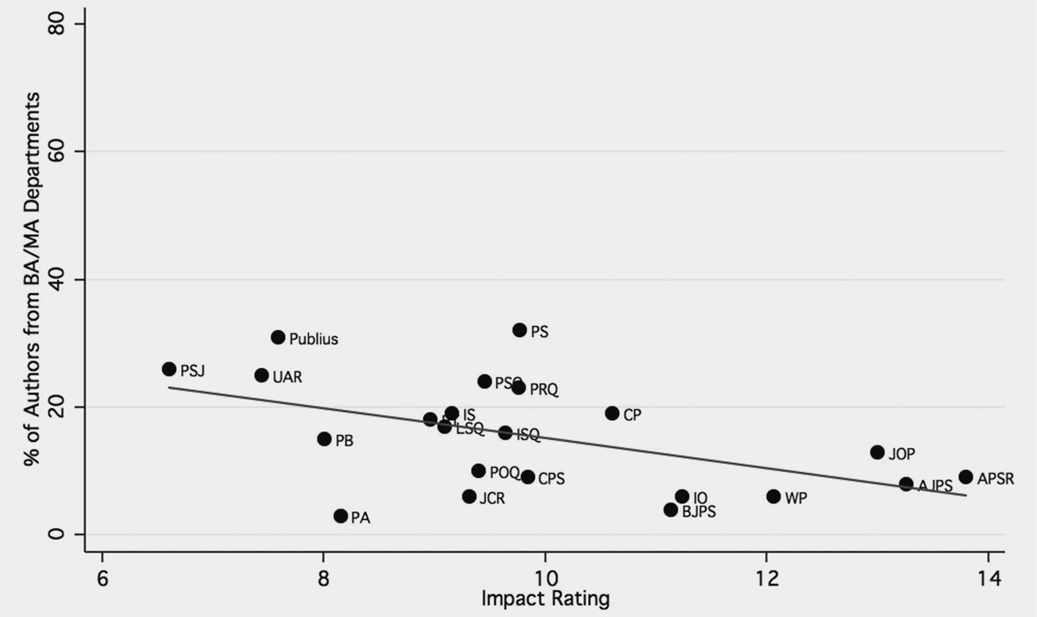
Figure 3 Relationship between Impact Rating and Percentage of Authors from Non-Ph.D. Departments
The journals above the line of best fit have a higher than expected proportion of authors from non-Ph.D. departments. For example, Publius, Political Science Quarterly, and Political Research Quarterly are well above the line, indicating that authors from non-Ph.D. departments publish at higher rates than expected in these journals, given the publications' impact rankings. Journals appearing below the line have a lower proportion of non-Ph.D. authorship than expected from the impact rating. In the Journal of Conflict Resolution, British Journal of Political Science, and International Organizations, authorship by faculty from non-Ph.D. departments was less than expected, given these journals' impact rankings. As for the top three political science journals, scholars from non-Ph.D. departments represented just over 9% of the authors in the American Political Science Review, 8% of the authors in the American Journal of Political Science, and over 13% of the authors in the Journal of Politics.
Publication patterns are not the only way to examine the contributions of political scientists from non-Ph.D. departments. Editorial boards represent an important but rarely studied collection of productive scholars, and their members are often drawn from the pool of a journal's frequent contributors. We expect patterns of representation on editorial boards to be similar to patterns of representation in the pages of the journal.
As figure 4 shows, political scientists from non-Ph.D. departments fill a significant number of positions on the board of the Journal of Political Science Education and, to a lesser extent, the boards of journals such as PS: Political Science and Politics (29%), Publius (20%), Legislative Studies Quarterly (18%), and State and Politics and Policy Quarterly (12%). However, many journals show much lower percentages of editorial board members from non-Ph.D. departments. For example, eight of the journals in this study (British Journal of Political Science, Comparative Politics, International Organizations, Policy Studies Journal, Political Analysis, Public Opinion Quarterly, Urban Affairs Review, and World Politics) lack a single editorial board member from a non-Ph.D. institution.
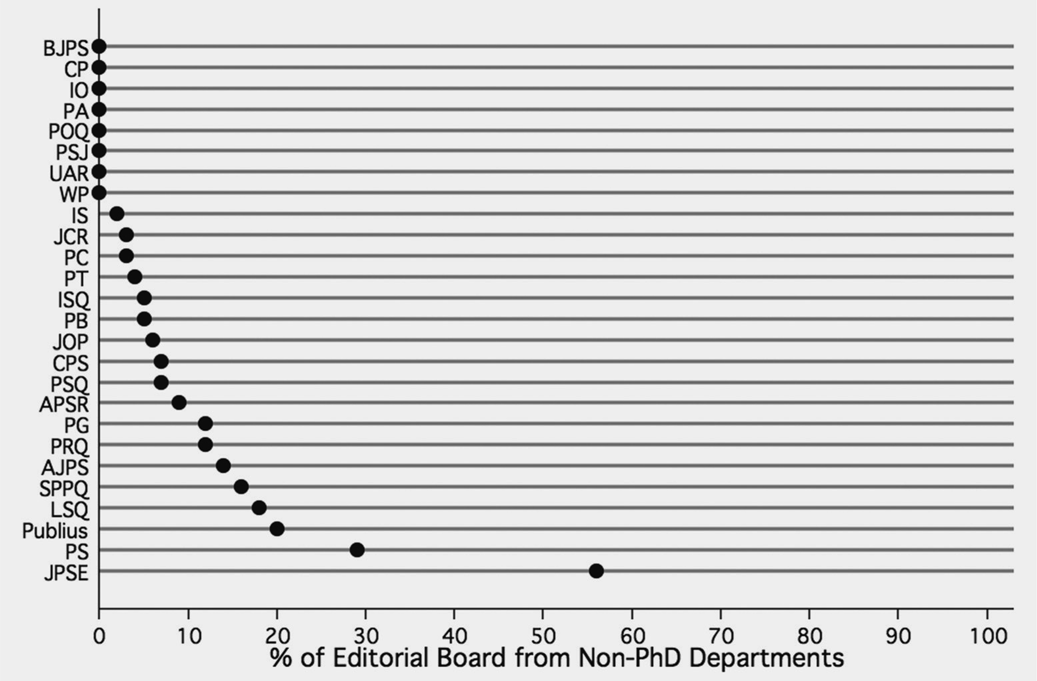
Figure 4 Editorial Board Membership, by Journal
Overall, scholars from non-Ph.D. departments fill 9% of the 2008 editorial board seats in the 26 journals included in this study. This number is much lower than the 16% of authors from non-Ph.D. departments who publish in political science journals. Further, 23 of the 26 journals included in this study have a lower percentage of editorial board members from non-Ph.D. departments than the percentage of published authors from non-PhD departments.
CONCLUSIONS
The contributions of scholars from non-Ph.D. departments have been largely ignored by studies of the discipline. Our results suggest that approximately 16% of authors in the 26 journals in our sample are from non-Ph.D. departments. For the first time, we also show empirical evidence that publication patterns differ widely by journal type, confirming a long-held presumption in the discipline. The three most prestigious journals are primarily the purview of scholars from Ph.D.-granting departments. Journals that focus on the scholarship of teaching and learning include many more contributions from scholars from non-Ph.D. departments. Subfield journals have much more variation. For example, few scholars from non-Ph.D. departments publish on political methodology, while subfields such as federalism, urban politics, and policy studies are more dominated by scholars from non-Ph.D. departments.
Similar to publication patterns, the institutional affiliations of editorial board membership also vary by journal. A few journals include no editorial board members from non-Ph.D. departments, despite publishing a considerable number of articles by authors from these schools. While almost 16% of authors come from non-Ph.D. departments, less than 9% of editorial board members hail from these departments.
Our findings also suggest a number of interesting directions for future research about the discipline. Most important, political science rankings should include scholars from all types of departments. Additional studies of the scholarly contributions of non-U.S. academics and people outside of academia should also be conducted. Future work can determine whether scholarly productivity is influenced by teaching load, research support, endowment, department size, and start-up packages. These results would be of considerable interest to department heads, deans, and other university administrators who wish to effectively incentivize and reward research activities.







